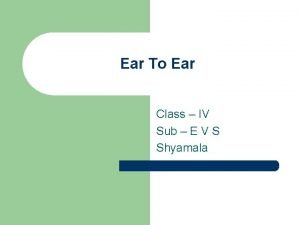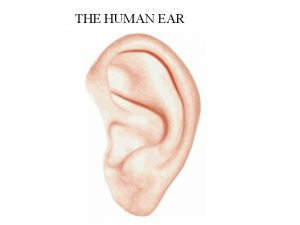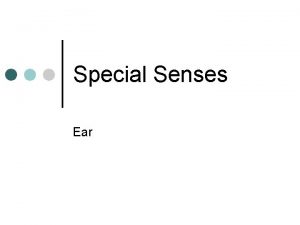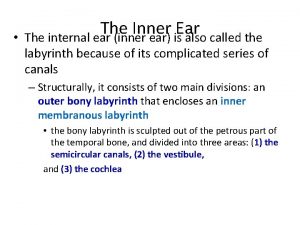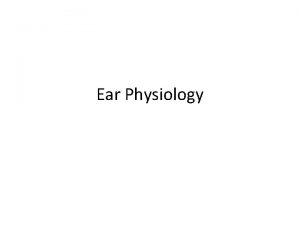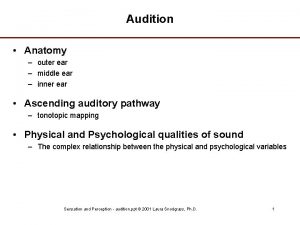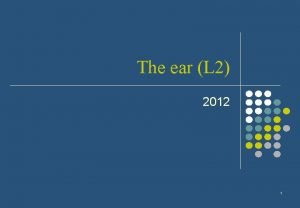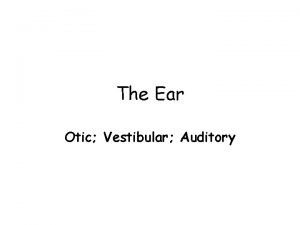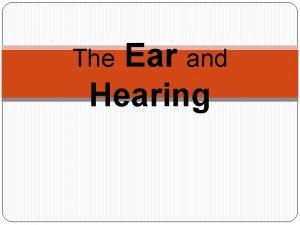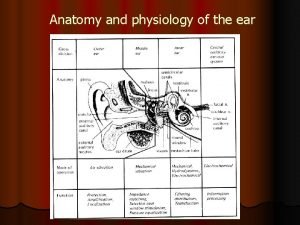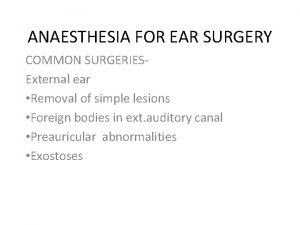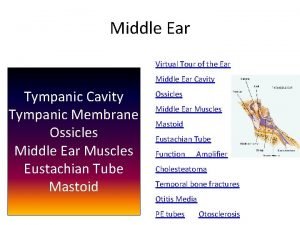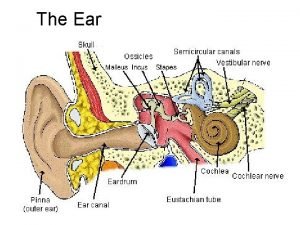THE HUMAN EAR What can we hear We































- Slides: 31

THE HUMAN EAR

What can we hear? We can hear sounds from a frequency of 20 Hertz [that is twenty vibrations per second] to an upper limit of 20, 000 Hertz [that is twenty thousand vibrations per second]. This upper limit decreases with age. We say that the human hearing range is from 20 Hz to 20 k. Hz [kilo. Hertz]. 20 Hz is deep bass and 20 k. Hz is very high treble. We are most sensitive to sounds in the 2 – 3 k. Hz region and much less sensitive to low bass and high treble sounds. We can detect a very wide range of sound levels over a ratio of about 1000000: 1 This is often called a ratio of 120 d. B.

What is sound? Any surface that vibrates in air produces sound waves A loudspeaker is a good example.

Travelling Sound Wave A sound wave in air consists of pressure variations which travel away from the source. This causes the air molecules to “ bunch together “ in the higher pressure regions. These are called “longitudinal waves”.

The parts of the ear

Schematic diagram of the ear

“ 3 D” view of the ear structure

The outer ear The sound waves go into the ear and travel down the ear canal. They strike the eardrum and some of the wave is reflected. This reflected wave combines with the incoming wave to produce a resonance at a frequency around 3. 7 k. Hz. This means that our hearing in this frequency range is very sensitive.

The eardrum vibrates when the sound waves bounce off it The vibration is at the same frequency as the incoming sound wave This vibration is transferred to the bones of the middle ear [called the Ossicles]




The middle ear The three bones in the middle ear are necessary in order to allow the eardrum vibrations to actually get into the COCHLEA where the sound waves are detected. Without these bones the sound waves would simply bounce off the cochlea and there would be no transfer of vibrations or energy. The bones allow a much higher pressure to be exerted on the cochlear fluid, thus enabling it to be moved.




The Cochlea: Why It’s Shaped the Way It Is Starting with a simple model of a spiral, the research team calculated how the cochlea’s curve affects the movement of sound energy inside the inner ear. Like the Whispering Gallery in St. Paul’s Cathedral in London, whereby a whispered voice travels along the curved wall to be heard on the opposite side of the room, the researchers found that sound energy preferentially travels along the outer wall of the cochlea. As this occurs, the fluid sloshes higher on one side, the basilar membrane wave tilts more to one side, and the hair cells, which are sensitive to motion at right angles to the direction of the wave, get an added push, causing them to bend. The effect is strongest at the centre of the spiral, where the lowest frequencies are detected, said the researchers, who calculated an increase in sensitivity by as much as 20 decibels. The ability to hear low-frequency sounds, which travel the farthest of all sounds, is especially important to mammals for communication and survival. VERY CLEVER DESIGN

What biologists miss out when they describe the ear!! Interesting fact: The speed of sound in water [like cochlear fluid] is about 1500 m/s The unwound length of the cochlea is about 3. 5 cm It takes a sound wave about 23 microseconds to travel down the cochlea and the same time to go back down to the round window. This corresponds to a frequency of about 22 k. Hz which is roughly our upper limit So the shock wave This means that all the fluid in the cochlea can move together at normal frequencies. It goes to the end of the spiral and through a gap and then back down again. This is why the round window is needed. When the oval window is pushed in, the fluid motion pushes out the round window. Without the round window, the cochlea could not function. BUT There is another kind of wave that travels down the cochlea

Basilar membrane waves These travel down the cochlea at a much slower speed than sound waves. Due to the steadily increasing width of the basilar membrane, different sections respond best to different frequencies, allowing us to hear pitch and tone.

The width of the Basilar membrane increases along its length. This enables the various points along its length to respond to different sound frequencies.

The cochlea

The hair cells and nerves that detect vibrations are located in the Organ of Corti.

The Organ of Corti Outer hair cells do not send nerve signals to the brain, but they mechanically amplify low-level sound that enters the cochlea. The amplification may be powered by the movement of their hair bundles, or by an electrically driven motion of their cell bodies. The inner hair cells transform the sound vibrations in the fluids of the cochlea into electrical signals that are then relayed via the auditory nerve to the auditory brainstem and to the auditory cortex.

The design and function of the human ear is so complex and well designed that it could not possibly have evolved. An integrated functional structure like this could not have developed “gradually”. The whole system needs to be in place for hearing to function properly. But there is yet more We need to have an auditory analysis system to make sense of the nerve signals sent out by our ears. Ears without analysis are as much use as a TV broadcast without a television.

What can the ear/brain system do? Identify musical notes/frequency Appreciate harmony Identify a musical instrument by its harmonics and its attack/decay profile Hear individual instruments when several are playing simultaneously Recognise speech Isolate a conversation in a noisy environment Locate a source of a sound in front of us [stereo hearing] This level of auditory processing/analysis cannot be matched by any computer system.


And finally ……………. . to give a balanced presentation THE SEMICIRCULAR CANALS These are three hollow fluid filled tubes next to the cochlea. They don’t help our hearing but the loose particles can stimulate nerve cells. When we rotate, the fluid in the tubes resists being turned, and flows in the tube thus stimulating nerve cells. This tells our brain whether we are stationary or starting to rotate about any axis.

HOW EVOLUTIONISTS BELIEVE HEARING STARTED The anatomy of the first amphibian ears was quite a bit simpler than modern ears. It is believed that early amphibians and even some amphibians living today, such as salamanders, heard by picking up vibrations through the ground and water. These vibrations would be picked up by the creature’s entire body but mostly by the dense parts such as bones. As the vibrations travelled through the body, they would reach the inner ear. This primitive inner ear contained a fluid filled region that was surrounded by dense bone. The vibrations would cause the dense bone to resonate, which in turn would transfer the vibrations to the fluid. Tiny hairs in the fluid region would convert the fluid vibration into electrical signals that would travel through nerves to the brain. The brain would then interpret these signals as sounds. This structure was sufficient in the water because the vibrational energy in water was adequate to cause the dense bones to vibrate. In air, however, the vibrations have much less energy and are therefore more difficult to interpret sounds with this structure. Indeed the first amphibians, like modern salamanders, probably heard the world by picking up vibrations through their skulls from the ground. Regardless of these limitations, it is clear that vertebrates had the early stages of an inner ear shortly after they crawled up on to the land (Manley, 1998). So you must have a fluid filled bone cavity plus specialised hair cells plus dedicated nerve pathways plus a brain that can interpret these signals as sound and respond in some positive way so as to give a motive for natural selection to work. This mechanism could not have evolved one step at a time.

It is likely that the middle ear and the Eustachian tube evolved from the respiratory apparatus of the fish, while various inner ear structures were developed from parts of the fish jaw. Eventually, the inner ear began to change and develop, in combination with new environmental pressures. It is probable that a small region of the inner ear partially responsible for balance evolved into the membrane of the oval window, which was flexible enough to transmit changes in air pressure to the fluid in the inner ear. At the same time, the inner ear was increasing in size and complexity. In amphibians, a small bulge appeared in the vestibular region of the ear, and as evolution proceeded, the bulge eventually developed into the spiralled cochlea which today forms the hearing mechanism of the inner ear of all vertebrates. The range of frequencies which the ear is able to detect and analyse is likely the result of evolutionary pressure to decode complex speech sounds. Similarly, the amplitude range probably evolved in response to the loudest sounds in the natural environment. This would include the cracks and booms of a thunderstorm at close range, as well as the loud roar of predatory animals. These sounds tend to rise slowly rather than abruptly. And this may explain why the ear has no defence against extremely loud sounds which occur suddenly, without warning.

If you believe that all of this complex and cleverly designed organ simply evolved gradually then to be honest you have not understood the elegance of the biological technology or the inability of blind chance mutations to create anything! Only our creator God has the power and intelligence to design and build such a wonderful sensory organ and to integrate this into our total brain information system The hearing ear, and the seeing eye, the LORD hath made even both of them. Proverbs 20 v 12

 William shakespeare
William shakespeare Animals whose ears cannot be seen
Animals whose ears cannot be seen Ear to ear worksheet class 4
Ear to ear worksheet class 4 Mark 4:23-24
Mark 4:23-24 Hear ye definition
Hear ye definition Human ear
Human ear Ear definition
Ear definition Our father all of heaven knows your name
Our father all of heaven knows your name I can hear you quite well. you not shout
I can hear you quite well. you not shout Can you hear me
Can you hear me How can they hear
How can they hear Hình ảnh bộ gõ cơ thể búng tay
Hình ảnh bộ gõ cơ thể búng tay Lp html
Lp html Bổ thể
Bổ thể Tỉ lệ cơ thể trẻ em
Tỉ lệ cơ thể trẻ em Voi kéo gỗ như thế nào
Voi kéo gỗ như thế nào Glasgow thang điểm
Glasgow thang điểm Hát lên người ơi
Hát lên người ơi Các môn thể thao bắt đầu bằng tiếng chạy
Các môn thể thao bắt đầu bằng tiếng chạy Thế nào là hệ số cao nhất
Thế nào là hệ số cao nhất Các châu lục và đại dương trên thế giới
Các châu lục và đại dương trên thế giới Công thức tiính động năng
Công thức tiính động năng Trời xanh đây là của chúng ta thể thơ
Trời xanh đây là của chúng ta thể thơ Mật thư anh em như thể tay chân
Mật thư anh em như thể tay chân Làm thế nào để 102-1=99
Làm thế nào để 102-1=99 Phản ứng thế ankan
Phản ứng thế ankan Các châu lục và đại dương trên thế giới
Các châu lục và đại dương trên thế giới Thể thơ truyền thống
Thể thơ truyền thống Quá trình desamine hóa có thể tạo ra
Quá trình desamine hóa có thể tạo ra Một số thể thơ truyền thống
Một số thể thơ truyền thống Bàn tay mà dây bẩn
Bàn tay mà dây bẩn Vẽ hình chiếu vuông góc của vật thể sau
Vẽ hình chiếu vuông góc của vật thể sau


